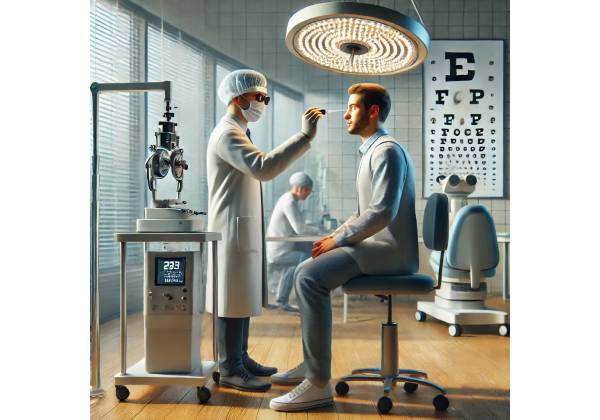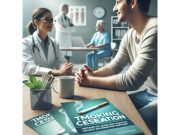Dry eye disease (DED) can be a debilitating condition, significantly reducing quality of life by causing chronic discomfort, fluctuating vision, and a constant reliance on lubricating drops. While many individuals find relief through artificial tears and lifestyle modifications, some patients suffer from persistent, severe forms of dry eye that demand more advanced therapeutic strategies. Autologous serum therapy has emerged as a promising, personalized approach to address these more challenging cases. By harnessing the healing components in a patient’s own blood serum, this therapy aims to restore ocular surface integrity, reduce inflammation, and improve tear film quality in a way that conventional over-the-counter products often cannot match.
In this comprehensive article, we explore the science behind autologous serum therapy, how it is clinically administered, what the latest research reveals about its effectiveness, and the practicalities of its cost and availability. Whether you are an eye care professional or a patient seeking more information, this deep dive will help you understand why autologous serum therapy is increasingly recognized as a pivotal intervention in the fight against severe dry eye disease.
A Closer Look at Autologous Serum Therapy: Personalized Solutions for Dry Eye
(Overview of the Therapy)
Autologous serum therapy, sometimes referred to as autologous serum eye drops (ASED) or serum eye drops, involves creating a topical ophthalmic solution from a patient’s own blood. The serum component is isolated, diluted (if necessary), and then administered as eye drops several times a day to manage severe dry eye symptoms. This approach leverages the biochemical similarity between serum and natural tears:
- Growth Factors: Autologous serum contains various growth factors that support corneal epithelial health, including epidermal growth factor (EGF) and nerve growth factor (NGF).
- Vitamins and Nutrients: Serum is a rich source of vitamins (e.g., vitamin A) and other nutrients crucial for ocular surface integrity.
- Immunoglobulins and Antioxidants: The presence of immune components may help control surface inflammation and safeguard against oxidative stress.
Unlike conventional artificial tears, which primarily aim to lubricate the ocular surface, autologous serum therapy closely mimics the composition of natural tears. This biochemical fidelity can be a game-changer for individuals who have not found sufficient relief through standard therapies. By directly nourishing epithelial cells and mitigating inflammation, autologous serum potentially addresses the underlying pathology of severe dry eye, rather than merely alleviating symptoms.
Why a Personalized Treatment Matters
Dry eye disease is multifactorial, with contributions from meibomian gland dysfunction, aqueous tear deficiency, immunological disorders, and external factors like screen time or contact lens wear. As a result, a “one-size-fits-all” approach frequently falls short in severe cases. Autologous serum therapy stands out for its individualized basis: each patient’s serum is uniquely suited to their physiological needs, reducing the risk of adverse immune reactions or allergies.
Additionally, serum-based therapy is adaptable. Depending on the patient’s condition, the serum concentration (20%, 50%, or even 100%) may be adjusted to ensure optimal tolerance and therapeutic effect. This flexibility can be especially valuable for individuals with ocular surface pathologies such as persistent epithelial defects, graft-versus-host disease (GVHD), or Stevens-Johnson syndrome (SJS), where off-the-shelf lubricants often prove insufficient.
Dry Eye Disease Demystified: Causes, Symptoms, and Consequences
(Understanding the Condition)
Defining Dry Eye Disease
Dry eye disease (DED) is characterized by tear film instability, hyperosmolarity, and chronic ocular surface inflammation. It manifests through a range of symptoms: burning, stinging, foreign body sensation, photophobia, and episodic blurred vision that may improve with blinking. The condition can be broadly classified into:
- Aqueous Deficient Dry Eye (ADDE): Reduced tear production by the lacrimal glands, commonly associated with conditions like Sjögren’s syndrome.
- Evaporative Dry Eye (EDE): Increased tear evaporation, usually linked to meibomian gland dysfunction (MGD).
However, many patients exhibit mixed etiologies, complicating diagnosis and management. Severe forms of DED can significantly hamper daily activities like reading, driving, and working on digital devices, leading to lower productivity and reduced quality of life.
Key Contributing Factors
- Aging: Tear production often declines with advancing age, leaving the ocular surface more prone to dryness.
- Hormonal Changes: Menopause and other hormonal transitions can disrupt tear film homeostasis.
- Autoimmune Disorders: Conditions like rheumatoid arthritis, systemic lupus erythematosus, and Sjögren’s syndrome frequently coincide with severe dry eye.
- Environmental Stressors: Air conditioning, low humidity, and prolonged screen use can exacerbate tear film evaporation.
- Medications: Antihistamines, antidepressants, and some antihypertensives reduce tear production or alter tear composition.
Consequences of Uncontrolled Dry Eye
If untreated, chronic dry eye can lead to further corneal damage, recurrent epithelial erosions, or even scarring in the worst cases. Patients may experience cyclical discomfort, rely excessively on artificial tears, and face restrictions in daily tasks. Psychological stress and reduced self-esteem often accompany persistent dryness and eye redness, reflecting how profoundly ocular surface disorders impact emotional well-being.
The introduction of therapies that address the biochemical deficiencies in the tear film, such as autologous serum, can break this cycle of damage and restore a more stable ocular environment. By targeting the foundational issues—nutritional support, epithelial healing, immunomodulation—serum therapy may provide a more integrated solution compared to standard lubricants alone.
How Autologous Serum Therapy Works: The Science of Natural Healing
(Mechanism of Action of the Therapy)
Key Components in Autologous Serum
Serum is the fluid component of blood from which cellular elements (red blood cells, white blood cells, and platelets) are removed. The result is a protein-rich solution that resembles human tears in pH and osmolarity. Specifically, autologous serum harbors:
- Growth Factors: EGF, TGF-β, NGF, and insulin-like growth factors that facilitate epithelial cell proliferation, migration, and wound repair.
- Cytokines and Immunomodulatory Molecules: Interleukin-1 receptor antagonists and other signaling proteins can help reduce inflammation on the ocular surface.
- Vitamin A: Vital for maintaining a healthy corneal epithelium, promoting goblet cell function, and ensuring proper mucin production in the conjunctiva.
- Albumin and Other Proteins: Contribute to tear film stability and supply essential nutrients, protecting the cornea from mechanical stress.
By delivering these elements directly to the ocular surface multiple times a day, autologous serum therapy fosters an environment conducive to corneal epithelial healing. Over time, improved epithelial integrity can reverse dryness-induced cell damage, reduce tear film instability, and alleviate symptomatic discomfort.
Complementary Effects on Tear Film Layers
The tear film consists of three primary layers: the lipid layer, aqueous layer, and mucin layer. Although serum eye drops do not directly replace the lipid component, they significantly bolster the mucin and aqueous layers. Enhanced epithelial health, for instance, can stimulate normal goblet cell function in the conjunctiva, increasing mucin production—a key factor for tear film spreading and adherence. By re-establishing a healthier ocular surface, the tear film becomes more stable and less prone to rapid evaporation or break-up.
Potential Anti-Inflammatory Action
Chronic inflammation frequently drives severe dry eye pathology. The presence of immunoglobulins (IgA, IgG) and anti-inflammatory mediators in autologous serum may mitigate excessive immune activity. Patients with autoimmune-based dry eye, like those with Sjögren’s syndrome, often exhibit heightened inflammatory markers in their tear film. Regular application of autologous serum can counterbalance this hostile environment, promoting a more controlled inflammatory response and reducing epithelial cell apoptosis.
Clinical Use of Autologous Serum Eye Drops: Steps, Dosage, and Administration
(Application and Treatment Protocols)
Producing Autologous Serum Eye Drops
- Blood Draw: Patients typically provide between 20–100 mL of blood, depending on the required volume and desired concentration. The draw is performed under sterile conditions in a clinical or laboratory setting.
- Centrifugation and Serum Separation: The collected blood is processed using a centrifuge to separate red blood cells, platelets, and clotting factors from the serum.
- Filtration and Dilution: The serum is passed through a filtration system to ensure sterility. It can be diluted with a balanced salt solution or other suitable solvents to achieve the specified concentration (commonly 20% or 50%, though protocols vary).
- Aliquoting and Storage: The resulting product is aliquoted into sterile dropper bottles or vials, which are then stored under refrigeration or frozen to preserve stability and prevent contamination.
Concentration and Dosing Schedules
- Typical Ranges: Concentrations from 20% to 100% serum are used; 20% is commonly chosen for moderate to severe cases, while higher concentrations may be indicated for persistent epithelial defects or extremely severe dryness.
- Frequency: Eye drops are often instilled four to six times per day, though more frequent dosing (up to every two hours) may be recommended initially for severe conditions.
- Duration: Many patients require consistent daily use for several weeks to months. Long-term therapy may be necessary in chronic cases; regimens can be tapered based on clinical improvement.
Practical Tips for Patients
- Refrigeration: Most autologous serum eye drops must be stored in the refrigerator when not in use to maintain stability. Patients should keep a small bottle at room temperature for daily administration, but rotate fresh aliquots from the fridge weekly.
- Discarding Expired Bottles: Autologous serum does not contain preservatives. It generally must be discarded after one to two weeks of use, or according to the compounding pharmacy or eye clinic’s guidelines.
- Hygiene Precautions: Patients should avoid touching the dropper tip to the eye or any other surface, minimizing contamination risk.
- Complementary Therapies: Standard dryness management, such as warm compresses, lid hygiene, and punctal occlusion, can be continued in parallel to maximize improvements.
Who is a Good Candidate?
Autologous serum therapy is particularly suitable for individuals with:
- Severe or Refractory Dry Eye that fails to respond to artificial tears or prescription eye drops (e.g., cyclosporine, lifitegrast).
- Neurotrophic Keratitis or Persistent Epithelial Defects requiring advanced healing support.
- Sjögren’s Syndrome or other autoimmune conditions that significantly reduce tear production.
- Post-surgical Dry Eye (e.g., following laser vision correction) when other interventions prove inadequate.
However, patients must have suitable venous access and a stable enough health profile to provide serum regularly. Those with blood-borne infections or clotting disorders may need special evaluation before proceeding with autologous serum therapy.
Safety and Efficacy of Serum Eye Drops: What You Need to Know
(Effectiveness and Safety)
Documented Benefits
Multiple clinical studies have demonstrated that autologous serum therapy can yield significant improvements in:
- Ocular Surface Staining: A decline in fluorescein and lissamine green staining indicates better corneal and conjunctival epithelial integrity.
- Tear Film Break-Up Time (TBUT): By supporting mucin production and epithelial health, serum drops can prolong the stability of the tear film.
- Subjective Symptom Relief: Patients frequently report less grittiness, burning, and photophobia when adopting autologous serum therapy.
- Visual Acuity: Smoother and healthier corneal epithelium can reduce refractive fluctuations, improving overall clarity of vision.
In many cases, these improvements manifest within weeks of consistent usage, although maximum benefits may take several months. Some clinicians also observe that continuing serum therapy can prevent relapse in chronic dryness, pointing to a long-term stabilizing effect on tear production and corneal health.
Potential Risks and Drawbacks
- Contamination or Infection: As autologous serum is free from preservatives, strict aseptic technique in preparation and usage is essential to avoid bacterial or fungal overgrowth.
- Inconvenience: Frequent daily applications, refrigeration, and the need for repeated blood draws can be burdensome, especially for patients who have limited mobility or needle phobia.
- Cost: Not all insurance plans cover serum eye drops, leading to out-of-pocket expenses for compounding, lab work, and repeated serologic procedures.
- Variability in Quality: Because serum preparation occurs in specialized facilities or compounding pharmacies, standardization can differ. Errors in dilution or contamination can reduce efficacy or compromise safety.
Adverse Reactions
Adverse events are relatively uncommon, but can include:
- Ocular Irritation: Some patients experience stinging upon instillation, particularly if higher serum concentrations are used. Adjusting the dilution or frequency often alleviates discomfort.
- Conjunctival Redness: A mild inflammatory response occasionally occurs, although it is usually transient.
- Rare Allergic-Like Responses: True allergy to one’s own serum is exceedingly rare, but certain additive solutions or antiseptics used during the preparation process might induce irritation.
Despite these considerations, autologous serum therapy is generally well-tolerated and recognized as a safe option for many forms of severe dry eye when prepared correctly. Eye care providers often weigh the therapy’s time and cost demands against the potential for substantial, longer-lasting relief, especially in cases that are resistant to standard medications.
What Current Studies Reveal: Clinical Insights into Serum Therapy for Dry Eye
(Current Research Insights)
Overview of Evidence
Dozens of peer-reviewed papers and clinical trials confirm the effectiveness of autologous serum in managing severe dry eye, persistent epithelial defects, and other ocular surface disorders. Although the majority of these studies are observational or relatively small-scale, they consistently report statistically significant improvements in corneal staining, tear film stability, and subjective comfort ratings.
Key Study Highlights
- Efficacy in Sjögren’s Syndrome: One well-known observational study tracked patients with Sjögren’s-related dry eye who used 20% serum drops four times daily for three months. The researchers documented a 50–60% reduction in corneal staining scores and a notable rise in Schirmer test values, reflecting improved tear volume.
- Persistent Epithelial Defects: A prospective trial of individuals suffering from non-healing corneal ulcers or epithelial erosions indicated that nearly 80% of participants achieved complete re-epithelialization within four weeks of starting autologous serum therapy. The presence of nerve growth factor and other healing mediators in serum was credited with accelerating tissue repair.
- Comparison with Artificial Tears: In a randomized controlled pilot, patients using autologous serum exhibited significantly greater improvements than those on preservative-free artificial tears in objective dryness metrics and overall ocular comfort at the eight-week mark.
- Long-Term Maintenance: Real-world follow-ups suggest that continued (although sometimes less frequent) serum application may prevent relapse or reduce the incidence of corneal erosions in chronic dry eye.
Ongoing and Future Directions
Researchers are investigating ways to optimize autologous serum therapy, such as:
- Higher Concentrations: Determining if 50% or 100% serum yields superior results in advanced disease without amplifying side effects.
- Enriched Serum Formulations: Adding growth factors or anti-inflammatory agents to further enhance clinical outcomes.
- Personalized Dosing Regimens: Adapting the dilution or frequency based on each patient’s tear film biomarkers, ocular surface imaging, or dryness severity scores.
- Allogeneic Serum: For patients who cannot provide adequate volumes of blood, donor serum from blood banks or close relatives might be an option, though immunological and infection-control concerns require careful consideration.
While the existing data are compelling, more large-scale, randomized, and placebo-controlled trials would help formalize autologous serum therapy as a mainstay for severe dry eye. Nevertheless, current literature underscores its unique ability to address multiple pathophysiological dimensions of DED, bridging the gap left by artificial tears and anti-inflammatory medications.
Practical and Financial Aspects: Cost and Accessibility of Autologous Serum Therapy
(Pricing and Accessibility of the Therapy)
Factors Influencing Cost
- Blood Draw and Lab Fees: Extraction and processing of blood can vary in price, especially if specialized lab equipment or staff are required to follow aseptic protocols.
- Production/Compounding Fees: After serum separation and dilution, the final product is typically prepared in a licensed compounding pharmacy or hospital-based facility. Costs may range from \$50 to \$200 (USD) per batch, depending on concentration, quantity, and geographic location.
- Frequency of Preparation: Because the shelf life of each batch is limited, patients may need fresh serum every 4–6 weeks (or more frequently in some cases). This repeat requirement adds to ongoing expenses.
- Clinical Consultation: Routine check-ups to monitor therapeutic efficacy and potential adverse events incur additional fees unless covered by insurance or hospital-based programs.
Insurance Coverage and Reimbursement
Insurance coverage for autologous serum therapy remains inconsistent. Some private insurers or national health systems reimburse a portion of the cost if the patient meets specific criteria, such as severe ocular surface disease unresponsive to standard treatments. In other cases, coverage may be limited or entirely absent, leaving patients with out-of-pocket expenses.
Eye care providers and compounding pharmacies can offer guidance on potential reimbursement pathways, as well as clinical justification letters that stress the medical necessity of serum therapy. Some philanthropic organizations or hospital-based funds may also assist low-income patients, especially when the intervention is essential for preventing corneal scarring or vision-threatening complications.
Access in Clinical Practice
- Large Ophthalmic Centers: Major university hospitals and specialized dry eye clinics often have in-house facilities for serum preparation, streamlining the patient’s experience.
- Community Settings: Smaller eye care practices might collaborate with regional blood banks or compounding pharmacies to coordinate serum production. This arrangement may necessitate travel to a facility that can handle the entire process safely.
- Home Delivery: In certain regions, specialized labs produce autologous serum eye drops and ship them on dry ice to the patient’s residence, maintaining cold-chain requirements and reducing the need for repeated clinical visits.
Despite these logistical hurdles, the growing demand for advanced dry eye solutions has motivated more healthcare systems to explore the cost-effectiveness of serum therapy. Some comparative analyses suggest that by reducing the frequency of corneal erosions or severe flare-ups, autologous serum could ultimately save money by preventing costly complications and emergency visits.
Meeting the Growing Demand
As the global burden of dry eye disease rises—fueled by screen-based lifestyles, aging populations, and the popularity of refractive surgeries—therapies like autologous serum gain broader recognition. Continuous efforts to improve standardization, cost transparency, and supply chain logistics will likely facilitate greater accessibility, enabling more patients with severe dry eye to benefit from this personalized, nutrient-rich treatment.
Disclaimer
This article is intended for educational purposes only and does not replace professional medical advice, diagnosis, or treatment. Always consult qualified healthcare providers regarding any questions or concerns you may have about a medical condition or treatment options.













